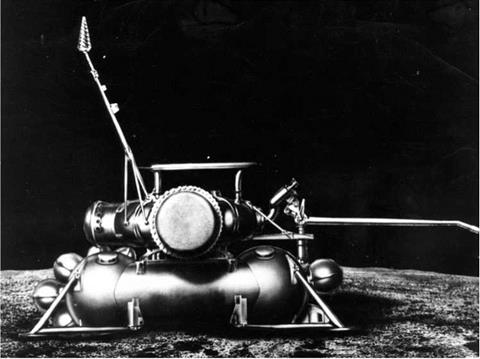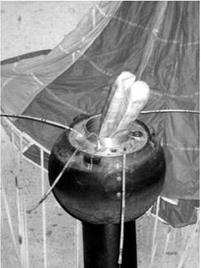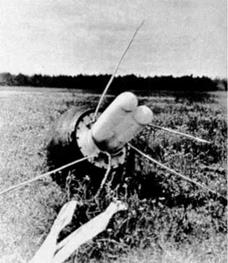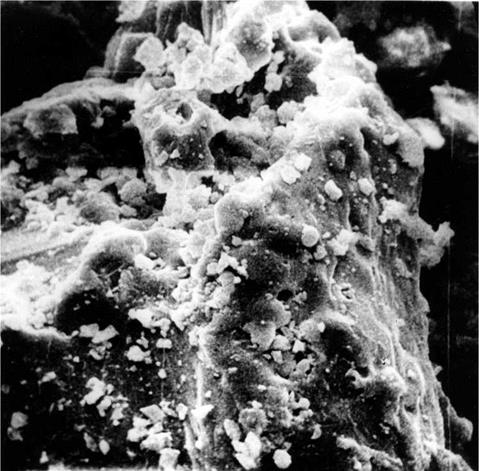THE GENIUS OF OKHOTSIMSKY
By the 21st, Luna 16 had spent a full day on the moon. There was still no official indication as to its purpose. Jodrell Bank reported still more strong signals. In fact, what Luna 16 was doing was checking out its exact landing coordinates so as to give the best possible return trajectory. Luna 16 had landed at the lunar equator at 56°E, the perfect place for the direct return to Earth on Dmitri Okhotsimsky’s passive trajectory. The return system would now be put to the test.
All was now set for the return of the ascent stage to Earth. The top stage of Luna 16 weighed 520 kg, with the recoverable cabin. There was one engine on the ascent stage, the KRD-61 of the Isayev design bureau. Burning 245 kg of UDMH and nitric oxide, the ascent stage had a specific impulse of 313 sec and could burn just once for 53 sec, sufficient to achieve a velocity of between 2,600 m/sec and 2,700 m/sec. A complication of the 2.9 day return flight was that – to recover the spacecraft in the normal Kazakhstan landing site – liftoff would take place out of sight from Yevpatoria: the moon would be over the Atlantic, where it could be followed by a Soviet tracking ship offshore Cuba.
Twenty-six hours after landing, explosive bolts were fired above the Luna 16 descent stage. On a jet of flame, the upper stage shot off and headed towards the white and blue Earth hanging in the distance. It headed straight up, motor still purring, building up to lunar escape velocity, its radio pouring out details from the four aerials poking out the side. The Sea of Fertility returned to the quiet it had known for eons. The descent stage was the only forlorn reminder of the brief visit. The lower stage on the moon continued to transmit signals for a couple of days until the battery ran out. Only two instruments seem to have been carried: a thermometer and radiation counter.
The returning rocket – capsule, instrument container, fuel tanks and motors – reported back from time to time as it headed for a straight nosedive reentry. These coordinates had to be as precise as possible so as to best predict the landing spot on Earth. At 48,000 km out, the tiny capsule separated from the instrument and rocket package, plunged into the upper atmosphere, glowed red and then white as temperatures rose to 10,000°C as it hit forces of 350 G. Helicopters were already in the air as a parachute ballooned out at 14,500 m. The capsule hit the ground and beacons began sending out a bright beep! beep! signal as rescuers rushed to collect the precious cargo. The mathematicians had done their job well, for Luna 16 came down 30 km from the middle of the intended recovery zone, 80 km southeast of Dzhezhkazgan, Kazakhstan.
|
Luna 16 stage left on the moon |
The small capsule was transferred to a plane and flown at once to Moscow to the Vernadsky Institute of Geological and Analytical Chemistry for analysis. The person in charge of assessing the lunar soil was Valeri Barsukov (1928-92), subsequently to become director of the institute (1976-92). How the scientists ever got the soil container open is a mystery for the entire outer skin of the capsule may well have been welded by the intense heat of the fiery return. Once open, the grey grains of moon dust poured out – loose lumps of dark grey, blackish powder like very dark, wet beach sand. It had small grains at the top and large grains at the bottom where it had begun to encounter rock.
The sample, although small (105 g), provided a considerable amount of scientific information [2]. The following were the main features: [11]
|
The Luna 16 cabin back on Earth |
It was a tremendous triumph. The Luna 16 mission had gone perfectly from start to finish. The tricky stages of soft-landing, drilling and take-off were just like the book said they should be. ‘It’s the decade of the space robot!’ heralded the Soviet press. The USSR made great play of how such flights were cheaper than manned flights like Apollo, how they did not expose humans to danger and how versatile space robots could land just about anywhere.
|
Luna 16 recovery |
|
Luna 16 moonrock |
For NASA and Western observers the real significance of Luna 16 lay elsewhere: it confirmed what many, but not all of them, had suspected was Luna 15’s real purpose, namely that it was a real challenge to Apollo 11a year earlier. Russia did have good grounds to celebrate Luna 16. Some of the remarks about its low cost and versatility were exaggerated and Luna 16’s sample of 105 g was tiny compared with Apollo, each mission of which brought back well over 20 kg. Luna 16 did not have the same capacity to search around for and select samples as the men of Apollo, for the arm would set the drill into the nearest piece of adjacent surface regardless. The Russians later exchanged 3g of Luna 16 samples for 3g each from Apollo 11 and 12. Many years later, the Russians sold 2 mg of soil at Sotheby’s in New York, fetching an out-of-the-world price of $442,500. The results of the soil analysis were published in a number of scientific papers over the following years.














